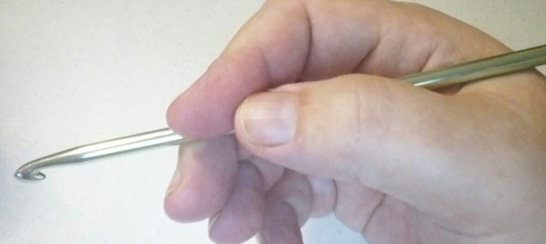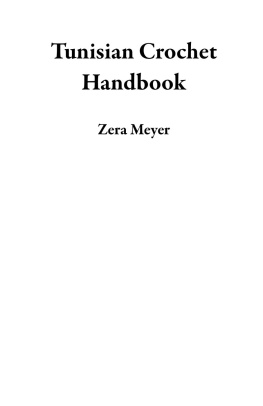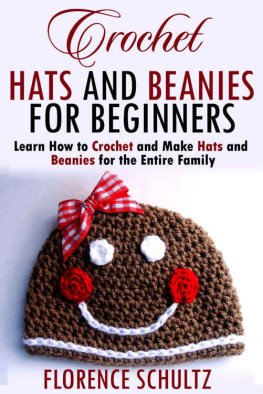Learn what equipment you need to crochet, the basics of Crochet, how to read written patterns, graphs, charts and diagrams, and more
Chapter One Equipment for Crochet
You dont really need a lot of equipment to begin to crochet. A nice set of hooks, a good pair of shears, some clip on stitch markers and youre ready to go. In this chapter well learn about the crochet hook, the different types of hooks used today, and how to hold the hook.
Anatomy of a Crochet Hook

Most crochet hooks are constructed in the same manner. The handle can vary in length and most hooks are either five or seven inches long. The flattened out portion of the handle is the grip and this is where you grip the hook to have control over it. Moving toward the head of the hook you will find the shaft, and then the throat of the hook leading up to the head of the hook. Besides the material such as aluminum, plastic, wood, and bamboo used to make the hook, the major difference in hooks is the length of the throat and the style of the hook head.

Inline hooks have a sharper more angular hook head. Tapered hooks have a more rounded and smooth hook head. Both types of head produce the exact same stitches, which one you choose is a matter of preference. Some crocheters say they like inline hook (such as a Susan Bates hook) because the grab the yarn better than tapered hooks, while others like tapered (such as Boye hooks) hooks because they feel they dont spilt the yarn as much as inline hooks. Try each type and see which one you prefer.
You can also find crochet hooks with cushioned handles. These handles can be made of polymer clay which has been baked, plastic, and large ergonomic handles for people who has trouble holding a crochet hook.
Crochet Hook Sizes
In the US most crochet hooks have a letter and number size designation. For example, one of my favorite hook sizes is I/9 (5.50mm). Most patterns call for hook sizes between E/4 (3/5mm) and K/10 (6.5mm). You may also find hooks with only the millimeter sizing. Use this chart to help you choose the correct size hook for your pattern.
US Size | Millimeter Size |
B/1 | 2.25mm |
C/2 | 2.75mm |
D/3 | 3.25mm |
E/4 | 3.5mm |
F/5 | 3.75mm |
G/6 | 4mm |
| 4.5mm |
H/8 | 5mm |
I/9 | 5.5mm |
J/10 | 6mm |
K/10 | 6.5mm |
L/11 | 8mm |
M-N/13 | 9mm |
N-P/15 | 10mm |
P/Q | 15mm |
Q | 16mm |
S | 19mm |
You may also find hooks with metric or UK/Canadian size designations. The US sizing corresponds to the number on US hooks. For example, a US I/9 (5.50mm) hook is equivalent to a UK/Canadian size 5 hook. Use this chart to help you translate US to UK/Canadian sizing.
US Sizes | Metric Sizes | UK/Canadian |
| 2.0 | |
| 2.25 | |
| 2.75 | |
- | 3.0 | |
| 3.25 | |
| 3.50 | - |
| 3.75 | |
| 4.0 | |
| 4.5 | |
| 5.0 | |
| 5.5 | |
| 6.0 | |
| 6.5 | |
- | 7.0 | |
- | 7.5 | |
| 8.0 | |
| 9.0 | |
| 10.0 | |
| 12.0 | - |
| 16.0 | - |
| 19.0 | - |
Steel Crochet Hooks
Steel hooks have very small hook heads and are used for crocheting with thread. Steel hooks are sized differently than other types of hooks. The smaller the number, the larger the hook. Some steel hooks are so fine that they are almost as sharp as needles.
STEEL CROCHET HOOK CONVERSION |
Metric (mm) | US | UK |
3.5 | | - |
3.25 | | |
2.75 | | |
2.25 | | 1 1/2 |
2.1 | | |
2.0 | | 2 1/2 |
1.9 | | |
1.8 | | 3 1/2 |
1.65 | | |
1.5 | | 4 1/2 |
1.4 | | |
1.3 | | 5 1/2 |
1.1 | | |
1.0 | | 6 1/2 |
.85 | | |
.75 | | - |
Tunisian Crochet Hooks
Tunisian crochet hooks, also called afghan hooks, are longer than traditional crochet hooks. This is because when you crochet using the Tunisian method the stitches are held on the hook as you work across the forward pass and then the stitches are worked off of the hook when you come back across the row. You can find single hooks which are quite long, and hooks with cables attached to them to hold the stitches.
How to HOld a Crochet Hook
There are two main schools of thought when it comes to holding the hook; the pencil hold and the knife hold. As the names imply with the pencil hold you grip the hook like you would a pencil. With the knife hold you grip the hook like you are going to cut a piece of food with a table knife. Both holds give you the same stitches, and it is a matter of personal preference on which hold you use. Use the one which feels most comfortable to you. Personally I use the pencil hold for the majority of my crocheting, but if Im working with a very thick yarn I may use the knife hold to give me more control and leverage to pull the yarn through the stitches.

Pencil Hold

Knife Hold
Shears, Stitch Markers, and Row Counters
Every crochet artists needs a nice high quality pair if shears which are only used on yard and thread. Guard your shears carefully and dont let anyone use them on paper. Paper will dull the blades and make the yarn or thread fray when you try to cut it. A nice set of clip on stitch markers is important to have, also. Stitch markers are used to mark the beginning and end of a pattern repeat, the beginning of a round, and to hold your active stitch when you need to lay your work down. Row counters can be as simple as a piece of paper and a pen or pencil, or you can find row counters which slip onto your finger. When you start to work charts and graphs a row counter will help you keep on the right track and not get confused.




















